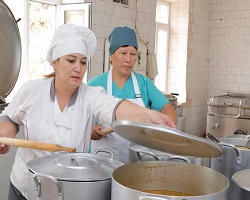From cooks to counsellors: keeping patients safe from harm

WHO/Almaz Zhumaliev
With people living longer and with multiple chronic conditions, medical care has become more complex and is being offered in diverse settings. Over the last decades, health-care workers have had to adapt to this changing landscape and continuously learn to improve patient safety. On the first ever World Patient Safety Day, being marked on 17 September, we see how those working in the health sector are committed to keeping patients safe from avoidable harm.
Behind the scenes
Baked chicken, rice and soups are on the menu today at the Republican Infectious Diseases Hospital in Bishkek, Kyrgyzstan, where Seitova Karamat works in the food service unit. “It’s our job to make sure that patients enjoy food that is not only tasty but also meets the doctors’ recommendations and is hygienically prepared and served,” says Seitova. “Hand hygiene is extremely important, as is keeping food fresh by storing it properly,” she adds.
Seitova is one of the thousands of health-care workers whose efforts are important to patient safety but whose work is not always visible. Among the invisible workforce are also orderlies, who help patients with everyday activities such as personal hygiene and eating, and help transport patients around the hospital facility. It is important that they are trained in patient safety, for instance in preventing accidents, such as falls, from occurring.
Janitors, who wash down and sanitize furniture according to hospital procedures, contribute to patient safety, as do staff in courier services, who ensure that boxes containing laboratory samples are handled gently and not left unattended in unsecured areas.
Checklists, standards and much more
For Elena Khasanova, Chief Nurse in a clinic in St Petersburg, Russian Federation, ensuring patient safety and the safety of her nursing staff is paramount. To support this, she has implemented several standards and checklists that help to catch errors before they happen and guarantee safety even in difficult situations – such as when patients experience anaphylactic shock or when nurses can only reach doctors via phone and must administer treatment on their own.
Not all areas of patient safety are as obvious as following the rigorous protocols and checklists already in place or practising hand hygiene. Physiotherapists have to make certain that their facility is accessible to those with reduced mobility; a laboratory worker needs to secure the area where laboratory samples are stored; and pharmacists double check the spelling of a patient’s name, to make sure that there is no misidentification.
Michell Hansen is one of 3 nurses tasked with helping patients transition from Hvidovre Hospital in Copenhagen, to their homes. “A large part of our job is to make the patient feel secure. Everything we do is with the patient’s involvement and acceptance,” she says. “We accompany often elderly and fragile patients from the hospital, and check the interior of their homes thoroughly – are they able to use the bathroom and toilet? Can they get in and out of bed by themselves? Do they have food and medicines? We gather all this information and provide it to the primary health care professionals who are charged with monitoring the patient’s progress,” explains Michell. All hospitals in Denmark offer the services of such teams, helping improve the safety of patients.
Learning from errors
Patient safety is also a policy matter. Hospital administrators, heads of medical care facilities, policy-makers and leaders at the top can improve patient safety by promoting an open and blame-free environment where everyone learns from errors.
Nanette Sylvest Hendil is a patient counsellor based at Rigshospitalet in Copenhagen. “My role is to guide and advise patients on reporting adverse events, to make sure that learning comes out of these errors. We find that most patients do not want to complain. But we help them report errors and help facilitate dialogue with the hospital department in question. I also perform a mediating role. If patients find it difficult to communicate with health-care staff, I can help,” says Nanette. “In Denmark, compensation for medical errors and complaints are decoupled.
Patients don’t have to lodge a complaint to be compensated. This has also helped promote a learning culture, where the focus is on open dialogue,” she adds.
As Nanette emphasizes, effective communication helps drive the culture of patient safety. Policies that help patients to report errors and encourage open discussion between caregivers and patients are key, as are policies that encourage staff to keep up with patient safety information through training.
Ultimately, policies that build environments where health-care workers and patients are engaged, valued and supported are crucial to making care safer.



